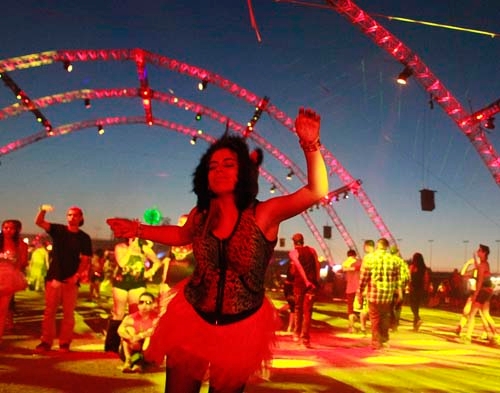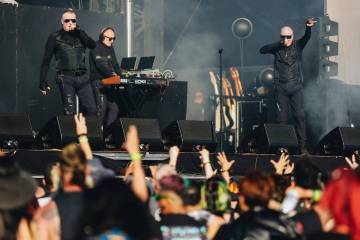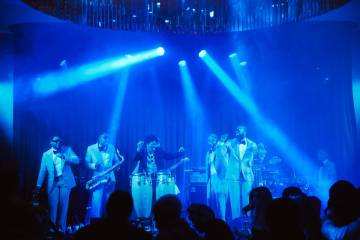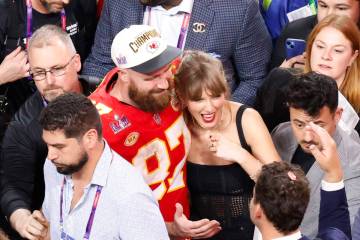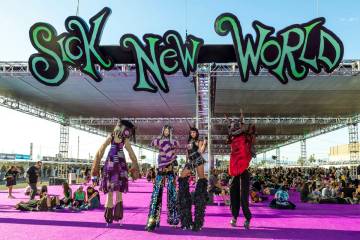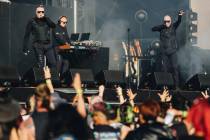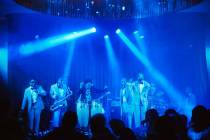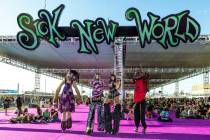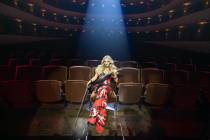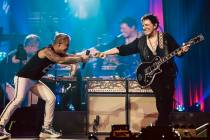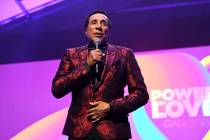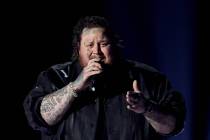Electric Daisy Carnival returning to Las Vegas, bigger than ever
Everything was outsized, the spectacle served in Hungry-Man portions.
If there was a Super Bowl of people-watching, the Electric Daisy Carnival would have been it, with a crowd, 230,000 strong over three days in June 2011, that was a dam burst of flesh, radiating energy like particles colliding to a beat.
They were set in perpetual motion by towering PA systems that bookended various stages, forming vibrating skyscrapers of sound.
Naturally, there was a Ferris wheel to ride at 4 a.m. and glowing sky divers who further illuminated the night, making it almost as bright as day, the sprawling grounds of the Las Vegas Motor Speedway pulsating from dusk until dawn with seismic dance music.
And just as immense as the production values were the numbers it generated.
The EDC's Vegas debut had an overall economic impact of $136 million in Clark County, supporting the equivalent of 1,400 full-time jobs and creating an additional $8.9 million in taxes, according to a study from Los Angeles-based research and consulting firm Beacon Economics.
On Friday, the EDC returns to the speedway in what is expected to be an even bigger event with a draw of 345,000 people, more stages, superstar headliners such as David Guetta, Tiesto and Kaskade and such larger-than-life flourishes as a $120,000 multimedia art installation piece.
"I want to create something that no one's ever seen," says Pasquale Rotella, founder of Insomniac Events, which puts on the EDC.
Now in its 16th year, the EDC has gradually become one of America's largest music festivals, and its relocation after originating in California means big business, filling lots of hotel rooms during the normally slower summer tourism months, with 90 percent of the EDC audience coming from out of town in 2011, according to Beacon.
"It's kind of like New Year's in June," says Clark County Commissioner Tom Collins, whose district includes the speedway. "Lots of music, lots of people, lots of money spent in Las Vegas."
POLICE INVOLVEMENT MINIMAL
When the Electric Daisy Carnival came to town, it brought plenty of apprehension with the requisite scantily clad revelers in fuzzy boots.
The EDC's reputation took a shot after its 2010 production at the Los Angeles Memorial Coliseum, where a 15-year-old girl died after an overdose of the drug Ecstasy.
Officials were wary of anything like that happening here, voicing concerns about safety issues and the potential for drug-related incidents.
Those fears were assuaged by a relatively tame EDC crowd that didn't engage in an inordinate amount of illegal activity for such a sizable gathering.
Police reported 29 felony arrests, mostly for narcotics, and 31 misdemeanor arrests during last year's festival.
"The crowd was fairly well restrained and seemed to be focused on the events of the evening and enjoying the music," says Metropolitan Police Department public information officer Bill Cassell. "Generally speaking, there were not a lot of calls for violent crimes."
As for health concerns, more than 300 attendees were treated by the medical staff on hand at the event, mostly for dehydration.
"A few people ended up in the hospital, but out of that many people, that could happen at a concert on the Strip," County Commission Chairwoman Susan Brager says. "They plan on more water stations this time."
There were, however, traffic issues related to last year's EDC, with gridlock on the way into the event on its opening Friday evening and some seriously slow going on southbound lanes of Interstate 15 on Monday morning as the departing EDC crowd ran into commuters.
In order to avoid that this year, the fest is ending at 5 a.m. instead of 6 a.m. as it did in 2011.
"That should help with commuters going to work," says Chris Powell, Las Vegas Motor Speedway president and general manager. "We've met on and off with (EDC organizers) for the past 52 weeks. We'll make some improvements based on things we learned last year, and most of that has to do with transportation."
Still, the EDC's return isn't without controversy, as Rotella was indicted in March in a corruption case involving officials at the L.A. Coliseum, though he has denied the allegations against him, and local officials don't seem troubled by how it has affected Insomniac.
"They went through some structural issues at the company, and they came to see me," County Commissioner Steve Sisolak says. "We talked about those things, and I'm comfortable with the situation that they're in. That's an internal issue that they're dealing with."
For his part, Rotella is more focused on the future of EDC than any events of the past.
He's already thinking of ideas for next year's show.
EDC POPULARITY EXPANDING
Since debuting in 1997 at Los Angeles' Shrine Expo Hall, the EDC has grown into a dance music behemoth that's expanded to several markets including Dallas; Orlando; San Juan, Puerto Rico; and others, with the Las Vegas stop being the EDC's flagship event.
The EDC has become such a brand name among scene enthusiasts that Rotella says it sells 80 percent of its tickets before a single performer is announced.
The EDC's move here arguably solidified Las Vegas as the dance music capital of the country, with the city's vibrant club scene hosting the world's most popular DJs on a weekly basis.
Dance music has soared in popularity nationwide in recent years, with mainstream pop heavyweights such as Usher, Rihanna and Lady Gaga incorporating house music flourishes into their sound and dubstep phenom Skrillex earning Grammy nominations and becoming a crossover star.
The music has never been bigger, and EDC has helped spur that growth, albeit without the high public profile of other big music gatherings such as Coachella, Bonnaroo and Lollapalooza, whose size EDC is beginning to rival.
"We were doing 40,000 people in '99, and no one even cared. It was like no one ever heard of us," Rotella says. "But it isn't about how big it is. The only reason that I like how big it is, is because I'm able to do more cool stuff."
ALWAYS LOOKING TO IMPROVE
The challenge for Rotella has been to continue to grow the EDC while still appealing to its core audience of dance music die-hards, who still consider themselves part of an underground community despite how popular their scene has become.
"When I play an event, I can feel if it's just a random promoter who is jumping on a new musical movement and he's advertising it to random people or if the spirit of house music is there," says French DJ-producer David Guetta, one of dance music's pre-eminent hit makers. "When I play Electric Daisy, I can feel that a lot of the people have been into this culture for a long time, even before it became so big. That makes a difference."
Rotella has cultivated the atmosphere that Guetta speaks of at the EDC at considerable expense. "When I used to have investors, back in the day, it wasn't a great situation because we've done events with 40,000 people, and we didn't make any money because that's not the priority," he says, noting the massive cost of mounting such elaborate productions. "It's way more intense for us as a team to blow people's minds and deliver something that's unique than to have a bigger profit at the end."
Clearly, Rotella's not out to lose money, but speaking with him, one gets the sense that putting on events such as the Electric Daisy Carnival is less of a way for him to make a living than it is his life itself.
"I love this. I will be doing this if there's 300,000 people or 300 people there," Rotella says, contemplating the latter scenario, as unlikely as it is. "I'd just have to go back to making the props myself."
Contact reporter Jason Bracelin at jbracelin@reviewjournal.com or 702-383-0476.
Related Story
Settlement reached in death of girl who died at 2010 L.A. Electric Daisy Carnival



